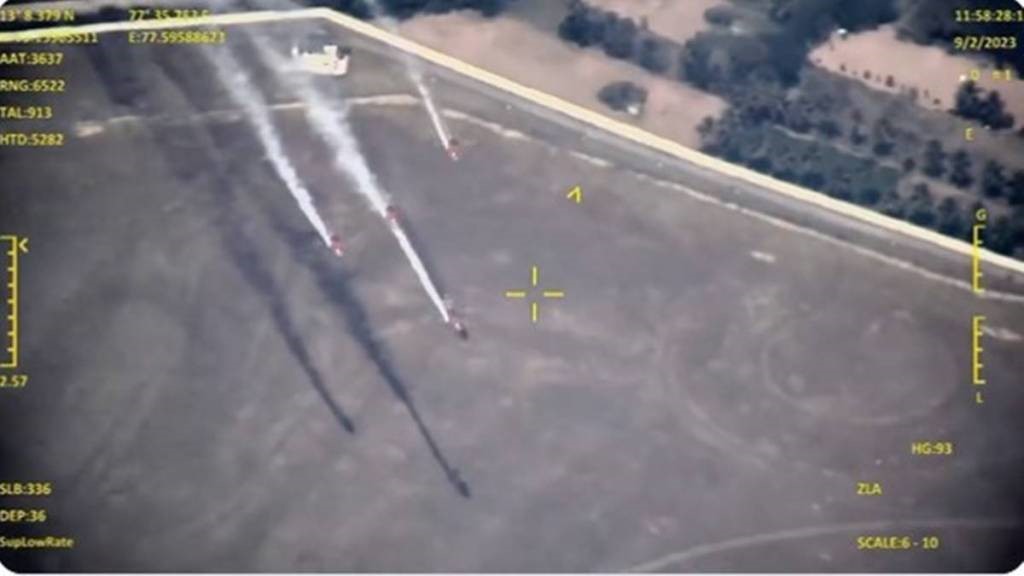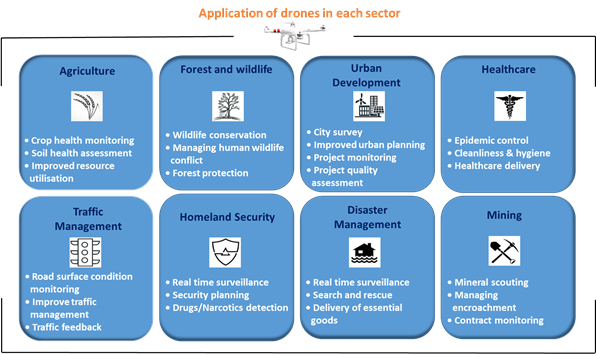
Copyright infringement not intended
Context: The Prime Minister has shared aerial coverage of Ground and Air display captured from indigenously developed Medium Altitude Long Endurance TAPAS UAV during rehearsal from height of 12000 feet.
Details:
About:
- Tactical Airborne Platform for Aerial Surveillance-Beyond Horizon-201 (TAPAS BH-201) is a Medium Altitude Long Endurance (MALE) unmanned aerial vehicle (UAV).
- It is being developed in the country by Aeronautical Development Establishment (ADE).
- In November 2016, the first flight of the UAV took place.
.jpeg)
General characteristics of TAPAS UAV:
Capacity: 350 kg (772 lb) payload
Length: 9.5 m
Wingspan: 20.6 m
Empty weight: 1,800 kg
Powerplant: 2 × NPO-Saturn 36T engines wing-mounted turboprop, 74.57 kW (100.00 hp) each (Prototype)
Powerplant: 2 × VRDE indigenous, 130 kW (180 hp) each (Production)
Propellers: 3-bladed constant-speed propeller
Performance of TAPAS UAV:
Maximum speed: 224 km/h
Ferry range: 1,000 km
Endurance: 24 hours
Service ceiling: 10,668 m (35,000 ft)
Drones:
- Drones or Unmanned aerial vehicles (UAVs) are aircraft with no on-board crew.
- The ‘drones’ can range from remotely piloted to fully automated, which means that it relies on a system of sensors and LIDAR (Light Detection and Ranging) detectors to calculate its movement.It can fly at a controlled level of height and speed for a long period of time.
- UAVs have a role in many aspects of aviation ranging from monitoring climate change to carrying out post disaster search operations, filming, communication in remote areas to military operations.
- UAVs first were massively deployed in the Vietnam War and began to be used in a range of new roles, such as acting as decoys in combat, launching missiles and dropping leaflets.
India's history of drones:
- Back in the 1990s, the Indian Army acquired unmanned aerial vehicles or UAVs from Israel, and the Indian Air Force and Navy followed suit. India first used military drones during the 1999 Kargil war against Pakistan for photo reconnaissance along the Line of Control (LOC).
- In India, the use of all (manned or automated) aerial vehicles is governed by the Directorate General of Civil Aviation (DGCA).Though UAVs were originally developed for the military and aerospace industries, drones have found their way into the mainstream because of the enhanced levels of safety and efficiency they bring.
New Drone Rules, 2021:
- The Central Government on 25th August 2021 has promulgated liberalised 'The Drone Rules, 2021' replacing the erstwhile Unmanned Aircraft System Rules 2021 ("Prior Rules"),to regulate the use and operation of Drones or Unmanned Aerial System ("UAS") in India.
- The Rules are based on the principles of "trust, self-certification and non-intrusive monitoring"by reducing the extent of regulatory control.
- The strict requirements under the Prior Rules like certificate of conformation, certificate of maintenance, operator permits, import clearance, authorization of R&D etc., have been abolished under the Rules.

Key Highlights of New Drone Rules
- The aim of the Rules is to create a 'digital sky platform' ("the Platform")which is a business-friendly single-window online system, with minimum human interference, where most of the permissions will be self-generated.
- The Rules have reduced the red-tape involved in the process of seeking compliance:
- Number of forms and types of fee has been reduced.
- Quantum of fee has been reduced to nominal levels and delinked with size of drone.
- Nano and model drones (made for research or recreation purposes) are exempt from type certification.
- Coverage of drones under Drone Rules, 2021 has been increased from 300 kg to 500 kg.This will cover drone taxis also.
- Type Certificate is required only when a drone is to be operated in India. Importing and manufacturing drones purely for exports are exempt from type certification and unique identification number.
Summary of provisions under New Drone Rules”
Scope of Operation
- The Rules cover all persons owning or possessing, or engaged in leasing, operating, transferring or maintaining a drone in India.
- It covers all drones that are registered in India or being operated for the time being, in or over India.
- It seeks to regulate only the civilian usage of Drones and does not apply to drones used by the naval, military or air forces of the Union.
Digital sky platform
- The Rules have established an online platform hosted by the Directorate General of Civil Aviation ("DGCA"), for the management of various drone-related activities in India.
- The Platform seeks to provide a single-window online system, where most of the permissions of Drones can be generated by individuals, without any human intervention.
Definition and Classification of Drones
- Drone has been defined as an unmanned aircraft system5("UAS"), that can operate autonomously or can be operated remotely without a pilot on board. The maximum all-up-weight for a drone is 500 Kilograms.
- Drones have been classified based upon the maximum all-up weight (not more than 500 kilograms7) including payload as under
- Nano drone: Less than or equal to 250 grams;
- Micro drone: Greater than 250 grams and less than or equal to 2 kilograms;
- Small drone: Greater than 2 kilograms and less than or equal to 25 kilograms;
- Medium drone: Greater than 25 kilograms and less than or equal to 150 kilograms; and
- Large drone: Greater than 150 kilograms.
In case, the weight is more than 500 kilograms, the provisions of the Aircraft Rules, 1937 shall apply instead of the Drone Rules.
Drone Certification
- The Rules mandate the requirement of obtaining a type certificate, from the Director General("DG")or any entity authorised by DG, on the recommendation of the Quality Council of India or an authorised testing entity, to operate the drone.
- However, a type certificate is not required for:
- Manufacturing or importing a UAS.
- Operating a model remotely piloted aircraft system or a nano UAS.
- In order to obtain certification of Drone, a person needs to apply. The proposal is then examined by the Quality Council of India ("QCI")or an authorized testing entity. The test report is then submitted along with its recommendations to the DG within sixty days from the date of receipt of the application, who on being satisfied with the recommendations, shall issue to the applicant a type certificate for the specific type of drone within fifteen days of receiving such test report.
- The drone needs to comply with certain mandatory safety features.
- 'No Permission – No Takeoff' ("NPNT")hardware and firmware;
- Real-time tracking beacon that communicates the drone's location, altitude, speed and unique identification number; and
- Geo-fencing capability.
Drone Registration
- In addition to Drone Certification, the Rules mandate the registration of individual drones and obtaining a Unique Identification Number ("UIN").
- Each UIN of a drone shall be linked to the unique serial number provided by the manufacturer and the unique serial numbers of its flight control module and ground control station. The Rules have also prescribed procedures for the transfer and Deregistration of Drones.
Drone Operations
- The Drone Rule 2021 draft also provides an interactive airspace map that includes the green, yellow, and red zones displayed on the Digital Sky Platform. The three zones have been defined as follows:
- Green Zone: Airspace over land or territorial waters of India, or Vertical distances of 400 feet or 120 meters and 200 feet or 60 meters at a lateral distance of 12 from the perimeter of the operating airport.
- Yellow Zone: Flying in this zone requires the prior approval of your Air Traffic Control Authority. This includes airspace above the vertical distance specified by the green zone.
- Red Zone: The use of UAVs is prohibited unless only permitted by the central government.
The Rules prohibit the operation of a drone in a red zone or yellow zone without prior permission. However, no such provision is required in the Green Zone.
Remote Pilot License
- The Rules restrict the operation of a drone by any person other than a holder of a valid Remote Pilot Licence (RPL) enlisted on the Platform. An RPL is not required for a person operating a nano droneor operating a micro drone for non-commercial purposes.
- In order to be eligible for the RPL the following criteria need to be fulfilled:
- Not less than eighteen years of age and not more than sixty five years of age;
- Have passed class tenth or its equivalent examination from a recognised board;
- Have completed the training prescribed by the DG for the applicable class of remote pilot licence from an authorised remote pilot training organisation.
- If a person, fulfils the aforementioned criteria, he can obtain an RPL after completing the training specified by the DG.
- The RPL shall be valid for a period of 10 years after which it can be renewed again.
Insurance
- The Rules require third party insurance of drones for compensation in case of damage to life and/or property caused by a UAS/drone. Insurance cover has to be taken in accordance with Motor Vehicles Act, 1988.
Offences & Penalties
- Any contravention of the Rules may attract a penalty of up to a maximum of one lakh rupees under Section 10A Aircraft Act, 1934. Furthermore, the Rules also provide for cancellation or suspension of any licence, certificate, authorisation or approval granted under these Rules by the DG in case of contravention of the Rules.
Applications of Drones:

Copyright infringement not intended


https://www.pib.gov.in/PressReleasePage.aspx?PRID=1898474






